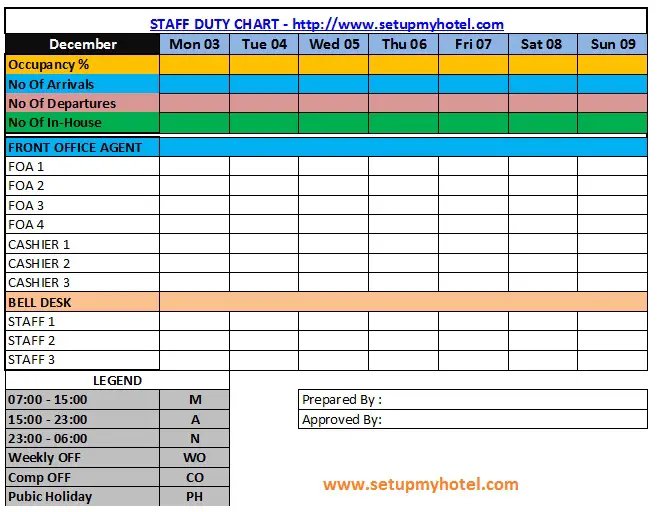Hotel Staff Duty Roster / Duty Chart Sample Format
A work shift or duty Chart shows the allotment of jobs, hours of duty, and days off for each member of the staff. The work shifts or timings may vary according to the hotel occupancy and peak business days. The duty chart also ensures that the staff has sufficient time to note their working schedule for the following week/month.
The duty chart/roasters specify to make for an even share of duties, the roaster should be rotated every five weeks. Duty roasters must be simple in format, easy to interpret, clearly written, and displayed on the staff notice board at least a week in advance
Duty Roster is usually prepared by the supervisors and then authorized by the HOD / ManagerManager is a person in the hotel operations who is assigned to manage or supervise a group of employ... of the department. The approved Duty rosters are then placed on the notice board of each department. Staff are not allowed to make any changes to the duty rosters, if any changes are required then the same has to be approved by the HOD / Manager.
Common work shifts in the hotel are:
- Morning 0700hrs to 1500hrs
- Evening 1500hrs to 2300hrs
- Night 2300hrs to 0700hrs
- General 0900hrs to 1800hrs
- BreakBreak�is the point in the laundry wash cycle at which a high-alkaline; soil loosening product is a... Shift 0700hrs to 1200hrs and 1800hrs to 2300hrs
Advantages Of Making a Duty roaster:
Planning a duty roaster helps to ensure:
- The exact number of staff required to be on duty at any given occupancy.
- That staff working hours are as per their employment contract.
- Regular off-days are availed to enhance productivity.
- Knowledge of which employees are present on the premises in instances of emergencies.
- Accuracy in attendance and payroll reports.
Steps for Planning and Making a Duty Roster:
Step 1: Ascertain occupancy levels and events expected in the hotel.
Step 2: Ascertain the spread of duty hours to be scheduled in the duty roaster, whether 12 hours, 16 hours, or 24 hours. Decide whether the positions will work for 5 or 7 days per week.
Step 3: Ascertain the type of shift-straight shift, break shift, rotating shift, or any other alternative scheduling to be used.
Step 4: Ascertain the number of full-time and part-time staff on the payroll.
Step 5: Ascertain the number of labor hours per day and per week required for various positions.
Step 6: Incorporate coffee breaks and mealtime allowances in the roaster.
Step 7: Ascertain that each employee gets a weekly off the day after 6 working days. Provide for compensatory offs. ScheduleA schedule is a report which gives supporting details to a property's financial statements. one reliever per 6 employees
Step 8: Ascertain closed days and restricted holidays, and any contingency planning that may be needed.
Download Sample Duty Roster Formats:











